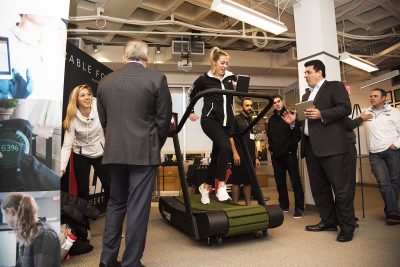
Athletes and scientists teamed up this Friday at Harvard Innovation Labs for a one-of-a-kind forum designed to let the STEM fields meet those in the playing fields.
The forum was titled “The Rise of the Quantified Athlete: An Experiential Forum on the Future of Athletic Performance,” and featured presentations and panel discussions from technology companies, doctors, scientists and professional athletes. The discussion was centered around the growing importance of technology and data collection in sports.
The highlight of the all-day event was the final panel discussion, which introduced sports technology from the perspective of an athlete. The panel included current and former professional athletes, as well as doctors and representatives from the National Football League Players Association.
“The most interesting conversations come from people with different perspectives,” Peter Gladstone, assistant director of consumer goods and services at Harvard Innovation Labs, said before the event.“This helps to have a deep, multifaceted conversation.”
The panel featured a diverse group of opinions on the role of data collection, sports technology and the future of the science.
“It was interesting to hear what all these athletes and entrepreneurs had to say about this kind of technology,” said Anne Gutmann, a sports research engineer at New Balance.
The conversation continued to cover data valuable to an athlete in their training and recovery process. For example, individuals talked about wearable, which are devices worn by athletes to capture data from their bodies such as heart rate, energy expenditure, sleeping patterns, nutrition and hydration.
“As an athlete you are worried about so many different things in terms of your training,” said Meghan Duggan, captain of the United States women’s national ice hockey team, in the panel discussion. “I need something that tells me when I’m ready to train in these areas today but not in these, and when I need to rest my body.”
There are different ways in which athletes can use wearables. Most commonly they are worn on the wrist, but sometimes on the chest, or attached to an athlete’s clothing or equipment.
“It’s about finding one that is comfortable and one that is going to give me the information that I need,” said Duggan, who had poor experiences wearing bulky, uncomfortable wearables underneath her pads during practice.
As useful as wearables are at helping players recover and train on their own, it has been a difficult process getting data collection technology implemented at an organizational level in many sports, as coaches tend to think more traditionally.
“It’s hard to get coaches to adopt technology,” said Matt Hasselbeck, an ESPN analyst and former Seattle Seahawks quarterback, who spoke to the audience from experience that coaches in the NFL favored tradition over change. “But once you introduce it and let that barrier down I think coaches would be willing to change.”
Yet in some respects, sports science has found its way into major sports organizations, mostly through player safety. One major example would be new concussion protocols introduced in the NFL in the last several years.
“Concussions weren’t about health. They were about toughness,” said Ryan Fitzpatrick, quarterback for the New York Jets, in the panel discussion. “But recently there has been a huge change in how the game is played.”
As technology and data collection take on a bigger role in sports, several members of the panel raised concerns about who has access to an athlete’s data, and whether that data is the property of the athlete or if it can be used by the team.
“I don’t want the coaches to know how fast I’m skating, or what my heart rate is,” said former Pittsburgh Penguins player Craig Adams, to the audience.
Adams said he was concerned that letting teams have access to an individual player’s data could point to deficiencies in their game, such as losing speed as a player gets older, that could hurt the player in contract negotiations.
Other players cautioned that over-reliance of data collection for athletes could diminish the role of intangible elements of the game that are crucial to sports.
“I would hate to lose perseverance and heart and commitment in sport,” Duggan said. “The quantified athlete could go in the direction of thinning that out.”
As the role of data collection and technology increases in every athlete’s lives, so does the threat of reducing their accomplishments to just numbers and data.
Each member of the panel stressed that while sports science can go a long way to help an athlete, it should by no means define an athlete.
“It’s an imperfect science,” Fitzpatrick said. “There are some things that aren’t quantifiable in sports and that’s how some of us made it to where we are today.”




